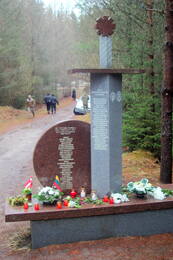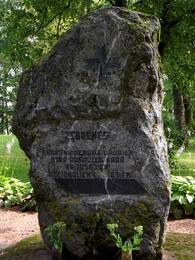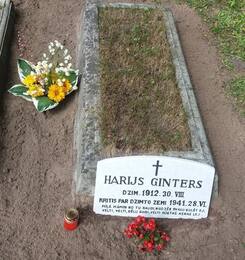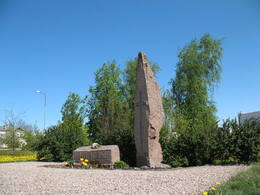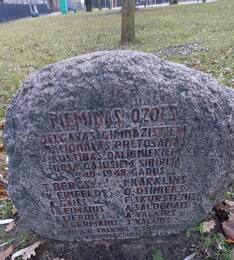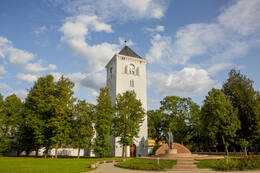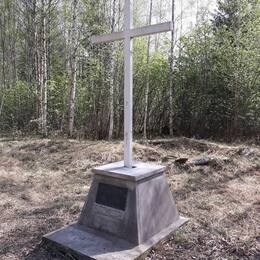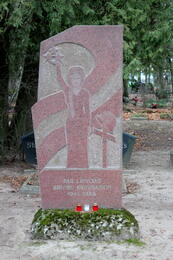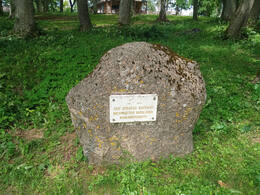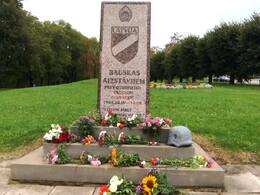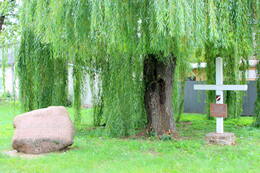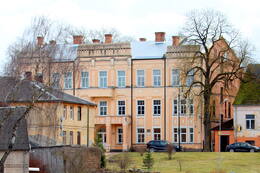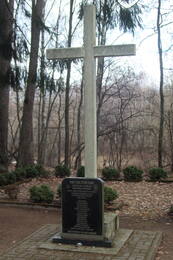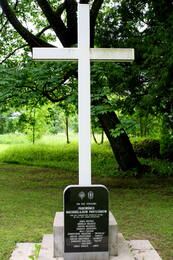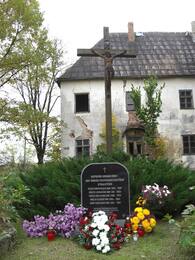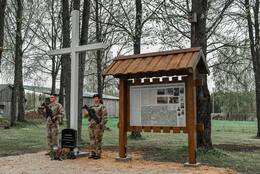Widerstand gegen das sowjetische Besatzungsregime in Zemgale
Ylės nacionalinių partizanų brolių kapinės Virkaus kapinėse, Bērzės parapijoje
Ylės nacionalinių partizanų brolių kapinės Bērzės parapijos Virkaus kapinėse buvo įkurtos 1992 m. lapkričio 14 d., kai čia buvo palaidoti 15 partizanų, žuvusių 1949 m. kovo 17 d. Ylės mūšyje. Tai tapo įmanoma po to, kai 1992 m. liepos 18 d. Nacionalinė gvardija kartu su organizacija „Daugavas Vanagi“ ir Latvijos istorijos tyrimų darbo grupe „Ziemeļblāzma“, dalyvaujant kitų tautiškai nusiteikusių organizacijų atstovams, atkasė 15 latvių ir lietuvių miško brolių, palaidotų susprogdintame partizanų bunkeryje Zebrenės parapijos Ylės girininkijoje, palaikus.
Atminimo akmuo Ylės mūšyje žuvusiems nacionaliniams partizanams buvo atidengtas 1993 m. gegužės 29 d. Jį sukūrė Alfonsas Kalniņšas („Edgarsas“), vienas iš išlikusių gyvų 1949 m. kovo 17 d. mūšio dalyvių. Taisyklingos formos granito plokštėje pavaizduotas kardas ir kylanti saulė, joje išgraviruoti 15 žuvusių nacionalinių partizanų vardai ir užrašas:
„Saulė patekėjo nuo kalavijo. Čia ilsisi Latvijos ir Lietuvos nacionaliniai partizanai, žuvę 1949 m. kovo 17 d. Ylės mūšyje.“
Nacionalinio partizano Bruno Drukio, žuvusio 1941 m., antkapinis paminklas Jaunsesavos kapinėse, Naudytės valsčiuje.
Antkapinis paminklas Bruno Drukio, nacionalinio partizano iš Naudytės valsčiaus, žuvusio 1941 m. birželio 30 d. susirėmime su sovietų okupacinės valdžios ginkluotais daliniais, atminimui. Granitinė stela su tekstu: „Partizanui Bruno Drukiui. Krito 1940 m. birželio 30 d. Ši žemė yra šventas mūsų tautos palikimas. Ir palaimintas tas, kuris už jį žūsta. Naudytės valsčius“. Keraminis medalionas su B. Drukio portretu buvo sudaužytas ir sunaikintas po Antrojo pasaulinio karo.
Prasidėjus Vokietijos ir SSRS karui, 1941 m. birželio 27 d. Ruženų miške susirinko apie dešimt vietos sargybinių, kurie suformavo nacionalinį partizanų būrį, kuriam vadovavo Žanis Gelsonsas. Kitą dieną partizanai užėmė Naudytės valsčiaus vykdomąjį komitetą ir vietos mašinų bei arklių nuomos punktą, perimdami ten buvusius traktorius, žemės ūkio techniką ir arklius. Birželio 30 d. Naudytės partizanų būrys bandė sulaikyti dviejų karininkų vadovaujamą Raudonosios armijos kareivių koloną kelyje netoli Melių. Susidūrimo metu žuvo ir sovietų karininkai, ir atsargos Latvijos armijos kavalerijos pulko kapralas Bruno Drukis.
Ylės nacionalinių partizanų bunkeris
Bunkeris yra Zebrenės seniūnijoje, Ylės girininkijoje, išsukus iš kelio P104 Bikstai–Aucė.
Ylės nacionalinių partizanų grupė, kuriai vadovavo Karlis Krauja, susikūrė 1947 m. Grupės vadu buvo išrinktas V. Ž. Briz ga (slapyvardis K. Krauja). 1948 m. spalį ši grupė susijungė su lietuvių nacionalinių partizanų grupe. Kraujos grupė veikė Jelgavos apskrityje, joje buvo 27 nacionaliniai partizanai. 1948 m. spalį Jelgavos apskrities Lielaucės valsčiuje, netoli Ylės girininkijos, 300 m į šiaurę nuo sodybos „Priedaiši“, Krau jos grupė įsirengė požeminį bunkerį. Jo bendras ilgis, įskai tant slaptus priėjimus, buvo 45 metrai. Aplink bunkerį buvo išdėliota 70 nuotoliniu būdu valdomų minų. Bunkeryje buvo įrengta krosnis, šulinys, tualetas ir sandėlis. 1949 m. kovo 17 d. bunkeryje buvę 24 partizanai stojo į savo paskutinį mūšį su 760 Valstybės saugumo ministerijos (čekis tų) karių. Po mūšio 9 partizanai buvo suimti, o 15 žuvo, iš jų – 8 latviai ir 7 lietuviai. 1992 m. krašto apsaugos kariai kartu su Dauguvos vanagais atkūrė susprogdintą bunkerį. Toje vietoje pastatytas Baltasis kryžius, paminklinis akmuo ir granito stela. Bunkerio viduje yra krosnelė, stalas ir siauri gultai, ant kurių miegojo partizanai.
Prie bunkerio yra informacijos stendai, paminkliniai akmenys su partizanų vardais ir pavardėmis.
Memorialas kovos su sovietine okupacija ir komunistinėmis represijomis aukoms Zebrenės parapijoje
Memorialas kovojusiems su sovietų okupaciniu režimu ir komunistinių represijų aukoms Zebrenės parke, Rengės dvaro parke, buvo atidengtas 1995 m. rugsėjo 1 d. Ant grublėto riedulio pavaizduotas kryžius ir iškalti žodžiai: „Zebrenės raudonojo teroro aukoms, Antrajame pasauliniame kare žuvusiems tautos kovotojams“. Memorialo sukūrimą finansiškai parėmė organizacija „Daugavos Vanagi“.
Latvijos ir Lietuvos nacionaliniams partizanams atminti skirtas paminklas Ukru parapijoje
Latvijos ir Lietuvos nacionalinių partizanų atminimo vieta prie buvusios Ukrų parapijos mokyklos buvo atidaryta ir pašventinta 2006 m. spalio 21 d. Joje pastatytas baltas kryžius, kurio papėdėje – granitinė stela su išgraviruotais dviejų Latvijos ir dviejų Lietuvos nacionalinių partizanų vardais ir tekstu: „Už Tave, Tėvyne. Ukrų parapijos nacionaliniams partizanams 1944–1954 m. Kovoje su komunistiniu okupaciniu režimu 1948 m. spalio 26 d. Ukrų parapijoje žuvo Eidis-Eduardas Ozolas, Kristaps Siļķe, Alfonsas Bugnius, Kostas Norvaitis“.
Atminimo vietą įkūrė Latvijos nacionalinė partizanų asociacija (LNPA) bendradarbiaudama su Lietuvos laisvės kovotojų asociacija (LLKS). Jos atidaryme dalyvavo Ukru parapijos tarybos pirmininkas Ainārs Āriņš, LNPA pirmininkas Ojārs Stefans, LLKS atstovas Jons Čepons ir kiti dalyviai.
1941 m. kritusio nacionalinio partizano Harijaus Günterso antkapinis paminklas Ūzinių Prieži kapinėse Zalenieki valsčiuje.
Antkapinis paminklas Jėkabniekų valsčiaus nacionaliniam partizanui Harijui Ginteriui, žuvusiam 1941 m. birželio 28 d. Ant kapo įrengta lenta su užrašu: „Harijus Ginteris. Gimė 1912 m. VIII a. 30 d. Žuvo už gimtąją žemę 1941 m. VI a. 28 d. Brangioji motina, ko verki, užgesink žvynus, eik miegoti. Veltui, veltui lauki sūnaus, veltui lieji karčias ašaras“. Antkapinis paminklas buvo restauruotas 2016 ir 2024 m. Zaļeniekų valsčiaus Ūzinių bibliotekos vedėjos Gunitos Kulmanės iniciatyva ir jos asmeninėmis lėšomis.
Po Vokietijos ir SSRS karo pradžios 1941 m. birželio 22 d. Jėkabniekų valsčiuje buvo suformuotas nacionalinis partizanų būrys, skirtas tvarkai užtikrinti ir sovietų okupacinei valdžiai nutraukti, o gvardijos būrio vadui vadovavo V. Ritumas. Iš pradžių silpna ginkluotė – keli pistoletai ir šautuvai – buvo papildyta trofėjiniais ginklais iš Raudonosios armijos kareivių, paimtų į nelaisvę netoli Kalnanšių ir kitose vietose. Didelis susidūrimas su sovietų ginkluotais daliniais įvyko 1941 m. birželio 28 d. Gudēniuose, kur buvo sugautas ir nukankintas Jėkabniekų valsčiaus sargyba ir nacionalinis partizanas H. Gintersas.
Paminklas Jelgavos gynėjams nuo sovietų okupacijos 1944 m. Grėbnerio parke
1995 m. gegužės 8 d. atidaryta atminimo vieta 1944 m. liepos–rugpjūčio mėn. vykusių Jelgavos gynybinių mūšių prieš antrąją sovietų okupaciją dalyviams. Šio įvykio garbei vyko pamaldos Jelgavos Šv. Onos evangelikų liuteronų bažnyčioje ir vėliavomis išpuošta procesija per Jelgavą. Atminimo vietoje stovi netaisyklingos formos granito stela, kurioje iškaltas kryžius, įaugantis į kalavijo smaigalį. Šalia, kairėje, žuvėdros pavidalu išdėstytas nupjauto gretasienio formos granito luitas su užrašu „Jelgavos gynėjams 1944.28.VII-8.VIII“.
Karas Jelgavoje prasidėjo po to, kai 1944 m. liepos 27 d. sovietų kariuomenė užėmė Šiaulius Lietuvoje ir tęsė puolimą šiaurės kryptimi. Siekdamas atremti Raudonosios armijos puolimą, naujai paskirtas Jelgavos karinis vadas generolas leitenantas Johanas Flugbeilis paskelbė miestą „tvirtove“ ir visos turimos pajėgos turėjo būti panaudotos miesto gynybai. Iš pradžių Jelgavos gynėjų branduolį sudarė tik 15-osios Latvijos SS ginklų divizijos mokymo ir rezervo brigados, vadovaujamos pulkininko leitenanto Hermano Jurko, kariai ir keli nedideli vokiečių daliniai. Liepos 27 d. popietę sovietų 3-ioji oro armija pradėjo bombarduoti Jelgavą, atakuodama ne tik strateginius karinius taikinius mieste ir jo apylinkėse – geležinkelio stotį ir kelius, – bet ir padegdama kai kuriuos gyvenamuosius pastatus. Miesto pastatai ir civiliai nukentėjo nuo „Katiušos“ raketų sistemų, artilerijos ir minosvaidžių ugnies, kurią viena į kitą apšaudė abi kariaujančios pusės.
Liepos 28 d. sovietų 3-iojo gvardijos mechanizuotojo korpuso daliniai pradėjo puolimą miesto pietiniame pakraštyje, tačiau nesėkmingai. Liepos 30 d. rytą puolimą sustiprino 51-osios armijos 279-oji ir 347-oji šaulių divizijos. Nors Maskvos radijas kitą dieną pranešė apie miesto užėmimą, SSRS kariuomenei su pastiprinimu pavyko įsiveržti į miesto centrą, bet ne visiškai jo užimti. Dešinysis Lielupės upės krantas ir įtvirtintas tilto galas prie Driksos tilto liko Raudonosios armijos neužimti. Įnirtingos kovos vyko ir Jelgavos pilyje, kuri rugpjūčio pradžioje perėjo sovietų kontrolei. Raudonoji armija perkėlė į pilį patrankas ir iš jos langų apšaudė vokiečių ir latvių kareivių pozicijas Kalnciemo kelyje. Po to sekė vokiečių sunkiosios artilerijos kontruguotė, kuri visiškai sunaikino pilį. Rugpjūčio 4 d., gavę pastiprinimą iš Rygos, Jelgavos gynėjams pavyko laikinai perimti miesto kontrolę. Tačiau masinis sovietų puolimas privertė vokiečių ir latvių kareivius po trijų dienų palikti Jelgavą.
Filozofu gatvėje 50 esančios Jelgavos 2-osios vidurinės mokyklos pastatas, kuriame 1945 m. mokėsi jaunimo pasipriešinimo organizacijos „Trijų žvaigždžių kolona“ nariai.
Dabartinės Paulo Bendrupo pradinės mokyklos (buvusios Kurčiųjų ir nebylių mokyklos) pastate Filozofu gatvėje 50, po to, kai 1944 m. liepos–rugpjūčio mėn. per sovietų–vokiečių karą buvo sunaikinta Jelgava ir miestas antrą kartą okupuotas sovietų, buvo įsikūrusi Jelgavos 2-oji (moterų) vidurinė mokykla. 1945 m. rudenį ten mokėsi keli jaunimo pasipriešinimo organizacijos „Trijų žvaigždžių kolona“ nariai.
1945 m. lapkritį sovietų saugumo institucijos suėmė 20 šios organizacijos narių, daugumai jų buvo vos 16–17 metų, tarp jų 13 vaikinų ir septynias mergaites, taip pat dar du jų rėmėjus. Jelgavos jaunimas buvo kaltinamas nelegalių susirinkimų organizavimu ir antisovietine agitacija, ginklų ir šaudmenų rinkimu, maisto tiekimu Cukraus fabriko filtracijos stovyklos kaliniams, paramos teikimu nacionaliniams partizanams Lietuvoje, taip pat kitais nusikaltimais prieš SSRS okupacinį režimą.
Pabaltijo karinės apygardos tribunolas 1946 m. gegužės 23 d. nuteisė 19 „Trijų žvaigždžių kolonos“ organizacijos narių, nuteistas 10 metų kalėti Gulago lageriuose ir 5 metams teisių apribojimo. Po devynerių metų kalėjimo Permėje, Bereznikuose, Norilske ir Karagandoje, jų grįžimas į tėvynę tapo įmanomas praėjus metams po Stalino mirties 1954 m.
Memorialas sovietų okupacinio režimo represuotų Jelgavos 1-osios vidurinės mokyklos pasipriešinimo judėjimo dalyviams Meiju gatvėje 9
Atminimo vieta Jelgavos 1-osios vidurinės mokyklos jaunimo pasipriešinimo organizacijos nariams, 1941 m. represuotiems komunistinio režimo, 2007 m. buvo įkurta visuomenės-politinio aktyvisto ir istoriko Andrio Tomašūno iniciatyva. Atminimo vietoje prie Jelgavos 1-osios gimnazijos (dabar – Jelgavos aukštesnioji technologijų mokykla) pasodintas ąžuolas ir pastatytas riedulys su iškaltu tekstu: „Atminimo ąžuolas Jelgavos gimnazistams, nacionalinio pasipriešinimo judėjimo dalyviams – žuvusiems Sibire 1940–1948 m. T. Bergui, V. Einfeldui, A. Gaišui, I. Leimaniui, J. Liepiniui, J. Jegermaniui, I. Kārkliņui, O. Ošeniekui, F. Skursteniui, A. Saldenaisui, A. Valkīrui, J. Valūnui. 2000. O. Valkīras, V. Treimanis ir 1-oji gimnazija“.
Jelgavos mokinių pasipriešinimo organizacija „Laisvoji Latvija“ buvo slapta įkurta 1940 m. rugsėjo 30 d. šešių vienuoliktos klasės Jelgavos 1-osios vidurinės mokyklos mokinių Fričo Skurstenio bute, Slimnīcas gatvėje 11-4. Organizacijai vadovavo Juris Valūnas, o jos narių skaičius buvo apie 20 žmonių. Jie rinkdavosi į nelegalius susirinkimus, kuriuose aptardavo organizacijos struktūrą ir veiklą. Jaunimas atspausdino antisovietinį šūkį „Ruoškitės!“, kurio 100 egzempliorių spalio 14 d. buvo iškabinti visame mieste. Nuo 1940 m. spalio 25 d. iki lapkričio 6 d. sovietų saugumo institucijos suėmė trylika Jelgavos 1-osios vidurinės mokyklos mokinių, kurie buvo įkalinti Jelgavos kalėjime ir ilgai tardomi. 1941 m. 1942 m. sulaikytieji buvo išvežti į SSRS, kur 1942 m. vasario 7 d. SSRS Vidaus reikalų liaudies komisariato specialusis posėdis nuteisė juos 10 metų kalėti. Išgyveno ir į Latviją grįžo tik Voldemaras Treimanis, o kiti Jelgavos 1-osios vidurinės mokyklos pasipriešinimo organizacijos nariai žuvo Gulago stovyklose 1942–1943 m.
Atminimo lenta sovietų okupacinio režimo represuotiems Jelgavos 1-osios vidurinės mokyklos rezistencijos nariams Akademijos gatvėje 10
Atminimo lenta komunistinio režimo represuotiems Jelgavos 1-osios vidurinės mokyklos (anksčiau Hercogo Pēterio gimnazijos) jaunimo pasipriešinimo organizacijos nariams buvo įrengta Latvijos politiškai represuotųjų asociacijos Jelgavos skyriaus 1996 m. spalio 24 d. Iš pradžių lenta buvo G. Eliaso Jelgavos istorijos ir meno muziejuje, tačiau po pastato fasado ir patalpų renovacijos 2007–2008 m. ji buvo perkelta ant išorinės muziejaus sienos dešinėje nuo pagrindinio įėjimo, šalia atminimo lentų, skirtų kitoms istorinėms asmenybėms. Lentėje iškaltas tekstas: „1940 10 26 suimti ir į Sibirą ištremti Hercogo Jēkabo gimnazijos mokiniai – antisovietinio judėjimo „Laisvoji Latvija“ nariai T. Bergsas, V. Einfeldsas, A. Engursas, A. Gaišsas, O. Leišmanis, I. Leigermanis,, Kārkmanis, I. Ošenieks, A. Saldenais, F. Skurstenis, V. Treimanis, A. Valkīrs, J. Valūns.“
Jelgavos mokinių pasipriešinimo organizacija „Laisvoji Latvija“ buvo slapta įkurta 1940 m. rugsėjo 30 d. šešių vienuoliktos klasės Jelgavos 1-osios vidurinės mokyklos mokinių Fričo Skurstenio bute, Slimnīcas gatvėje 11-4. Organizacijai vadovavo Juris Valūnas, o jos narių skaičius buvo apie 20 žmonių. Jie rinkdavosi į nelegalius susirinkimus, kuriuose aptardavo organizacijos struktūrą ir veiklą. Jaunimas atspausdino antisovietinį šūkį „Ruoškitės!“, kurio 100 egzempliorių spalio 14 d. buvo iškabinti visame mieste. Nuo 1940 m. spalio 25 d. iki lapkričio 6 d. sovietų saugumo institucijos suėmė trylika Jelgavos 1-osios vidurinės mokyklos mokinių, kurie buvo įkalinti Jelgavos kalėjime ir ilgai tardomi. 1941 m. 1942 m. sulaikytieji buvo išvežti į SSRS, kur 1942 m. vasario 7 d. SSRS Vidaus reikalų liaudies komisariato specialusis posėdis nuteisė juos 10 metų kalėti. Išgyveno ir į Latviją grįžo tik Voldemaras Treimanis, o kiti Jelgavos 1-osios vidurinės mokyklos pasipriešinimo organizacijos nariai žuvo Gulago stovyklose 1942–1943 m.
Jelgavos Švč. Trejybės bažnyčios bokštas
Jelgavos Švč. Trejybės bažnyčios bokštas yra Jelgavos miesto centre.
Bokštas stovi daugiau nei keturis šimtmečius ir yra tapęs ne tik miesto raidos, bet ir skaudžių įvykių liudininku. Bažnyčios statyba pradėta 1574 m., vykdant Kuržemės ir Žiemgalos hercogo Gothardo Ketlerio potvarkį. Jos bokštas buvo užbaigtas 1688 m., vadovaujant meistrui Martinui Knochui, ir tapo vienu labiausiai matomu miesto statinių. Antrojo pasaulinio karo metais Jelgava buvo smarkiai nuniokota, o bažnyčia sudegė 1944 m., po SSRS aviacijos antskrydžio. Po karo sovietų valdžia susprogdino altoriaus dalį, o sienos buvo nugriautos. Išliko tik bokštas kaip strateginės reikšmės objektas, kadangi jis buvo aukščiausias mieste. Per karą ir pokariu bokštas buvo naudojamas karinėms reikmėms – iš jo buvo stebimos priešo pozicijos ir kontroliuojama aplinkinė teritorija.
Pokario metais bokštas atliko strateginę funkciją, vykdant pasipriešinimo veiklą. Jis tapo slapta susitikimų vieta ir informacijos, svarbios kovai su sovietiniu režimu, perdavimo vieta. Šiandien bokštas, išlaikęs savo istorinę reikšmę, atgimė kaip kultūros ir švietimo centras.
Žemės ūkio akademijos pastatas Jelgavoje, Lielajos gatvėje 2, kuriame 1943–1944 m. dirbo Latvijos Centrinės Tarybos nariai
1943–1944 m. keli akademinio padalinio „Austrums“ ir Latvijos Centrinės tarybos, slapta įkurtos Rygoje 1943 m. rugpjūčio 13 d., nariai – profesoriai Rūdolfs Markuss, Andrejs Teikmanis, Alfrēds Tauriņš ir kiti dėstytojai. 1944 m. kovo 10 d. Žemės ūkio akademijos docentas Vilis Eihe kartu su žmona Aleksandrs ir asistentu Hermaniu Zeltiņus spausdino nelegalų LKP laikraštį „Jaunā Latvija“ Jelgavoje, naudodamas kopijavimo aparatą. Jame buvo skelbiamos žinios apie Latvijos tarptautinę padėtį ir nustatytos tolesnės Latvijos politinio gyvenimo gairės. Tarp 188 Latvijos visuomeninių-politinių darbuotojų, kurie 1944 m. kovo 17 d. LKP memorandume išreiškė poreikį atkurti nepriklausomą ir demokratinę Latvijos Respubliką, remiantis 1922 m. Konstitucija, buvo ir Žemdirbystės akademijos Jelgavoje akademinis personalas – profesoriai Jānis Vārsbergsas, Pāvils Kvelde, A. Teikmanis ir R. Markuss.
J. Rozentalio – J. Freimanio tautinės partizanų grupės narių atminimo vieta Iecavos valsčiuje
Janio Rozentalo – Janio Freimanio nacionalinių partizanų grupės narių atminimo vieta buvo įkurta 1996 m. Iecavos valsčiuje, J. Freimanio miško brolių grupės bunkerio vietoje. Ant betoninio pagrindo po baltu beržiniu kryžiumi galima iškalti užrašą „Už Latvijos laisvę žuvusiems nacionaliniams partizanams“ ir miško brolių – Janio Freimanio, Janio Kāpostinio ir Laimonio Zīrako, žuvusių 1950 m. sausio 11 d. buvusioje Garozos valsčiaus, Jelgavos rajono, teritorijoje, vardus. Už paminklo matoma bunkerio vieta, tačiau aikštės pakraštyje yra stendas su Bauskės muziejaus istoriko Raito Ābelnieka parengta informacija apie J. Rozentalo ir brolių Dūminių nacionalinių partizanų grupę, veikusią Iecavos, Misos ir Zālytės valsčiuose 1944–1947 m.
Janio Rozentālo vadovaujamas Miško brolių būrys buvo suformuotas 1945 m. vasarą, tačiau rugsėjį jame jau buvo 11 partizanų. Ši Miško brolių grupė veikė Bauskės rajono Iecavos ir Zalytės valsčiuose, taip pat Jelgavos rajono Garozos, Salgalės ir Pēterniekų valsčiuose. 1948 m. rugpjūčio 13 d. čekistams pavyko nužudyti būrio vadą ir jo brolį, sugauti dar tris partizanus, tačiau likę šios grupės Miško broliai, vadovaujami Janio Freimanio, tęsė kovą su okupantais.
Latvijos kareivių, žuvusių gindami Bauskę nuo sovietų okupacijos 1944 m., brolių kapinės Codes parapijos Butkų kapinėse.
Atminimo vieta Butkų kapinėse buvo įkurta po to, kai 1988 m. rudenį Bauskės aplinkos apsaugos klubo Bauskės skyrius sutvarkė maždaug 30 Latvijos kareivių, žuvusių 1944 m. Bauskės gynybos mūšiuose, kapus, palaidotus dviem kolonomis, ir nusprendė pastatyti paminklą. Vėliau buvo renkamos aukos paminklo statybai. Paminklas iš raudonojo granito, skirtas čia palaidotiems Bauskės savanorių bataliono kariams, buvo atidengtas 1989 m. lapkričio 25 d., tačiau jau 1990 m. gruodžio 4/5 d. naktį jį susprogdino SSRS okupacinė armija. 1992 m. paminklo vietoje buvo pastatytas masyvus medinis kryžius. 2002 m. spalio 13 d. buvo atidengtas naujas granito paminklas, panašus į anksčiau sunaikintą, su iškaltu tekstu: „Už Latvijos laisvę žuvusiems 1944 m.“.
Atminimo akmuo Bauskės savanorių batalionui Mežotnės valsčiaus Jumpravmuižos parke
Bauskės savanorių bataliono atminimo vieta Jumpravmuižos parke buvo įkurta 1990 m. buvusio šio bataliono kareivio Imanto Zaltinio iniciatyva. Ji yra toje vietoje, kur Latvijos kareiviai 1944 m. liepos pabaigoje sutrukdė pirmiesiems Raudonosios armijos daliniams kirsti Lielupės upę. Prie grubiai apdirbto riedulio pritvirtinta balto marmuro lenta su išgraviruotu aukso spalvos tekstu: „1944 m. liepos 28 d. čia buvo įsikūręs Bauskės savanorių bataliono vadovybės postas.“ Iš pradžių marmurinės lentelės vietoje buvo bronzinė lenta su graviūra, tačiau 10-ajame dešimtmetyje ją pavogė spalvotųjų metalų vagys.
1944 m. liepos pabaigoje, sovietų kariuomenei artėjant prie Bauskės, mieste, kuris neseniai buvo giliai užnugaryje, nebuvo jokių reikšmingų vokiečių pajėgų. Staigų Bauskės žlugimą sutrukdė ryžtingi Bauskės rajono viršininko ir sargybos pulko vado majoro Janio Uļuko veiksmai. Liepos pabaigoje jis suformavo Bauskės savanorių batalioną, kurį sudarė 13-ojo Bauskės sargybos pulko sargybiniai, policininkai ir savanoriai. Batalionas užėmė gynybines pozicijas Lielupės upės krantuose Jumpravmuižoje priešais Ziedonių salelę ir jau pirmąją dieną turėjo stoti į mūšį su puolančia Raudonąja armija. Mūšių metu prie bataliono prisijungė ir grupė Lietuvos policijos pareigūnų, kurie buvo pasitraukę iš Lietuvos į Latviją. Daugelis lietuvių žuvo, nes kovojo drąsiai ir negailėdami savęs. Pirmasis žuvo Lietuvos policijos kapitonas, kuris buvo palaidotas čia pat, Jumpravmuižos parke, šalia Pirmojo pasaulinio karo vokiečių kareivių kapų.
Paminklas Bauskės gynėjams nuo sovietų okupacijos 1944 m. Pilies sode
Paminklas Bauskės gynėjams 1944 m. buvo atidengtas 2012 m. rugsėjo 14 d. buvusio Bauskės savanorių bataliono kareivio Imanto Zeltinio iniciatyva, jam ir vietos valdžiai finansiškai parėmus. Ant raudono granito stelos, sumontuotos ant trijų pakopų betoninio pagrindo, išgraviruotas tekstas: „Bauskės gynėjams nuo antrosios sovietų okupacijos 1944.07.28.–1944.09.14.“ ir „Latvija turi būti Latvijos valstybė. Kārlis Ulmanis“. Po paminklo atidengimo kilo Rusijos ir Baltarusijos užsienio reikalų ministerijų bei vietinės Rusijos žiniasklaidos protestai, tačiau 2024 m. pavasarį paminklą netgi užpuolė vandalai. Nepaisant to, šioje vietoje kasmet rugsėjo 14 d. 14.00 val. vyksta Bauskės gynėjams skirtas atminimo renginys.
1944 m. liepos pabaigoje, sovietų kariuomenei artėjant prie Bauskės, mieste, kuris neseniai buvo giliai užnugaryje, nebuvo jokių reikšmingų vokiečių pajėgų. Staigų Bauskės žlugimą sutrukdė ryžtingi Bauskės apygardos viršininko ir sargybos pulko vado majoro Janio Uļuko veiksmai. Liepos pabaigoje jis suformavo Bauskės savanorių batalioną, kurį sudarė 13-ojo Bauskės sargybos pulko sargybiniai, policijos pareigūnai ir savanoriai. Batalionas užėmė gynybines pozicijas Lielupės upės krantuose Jumpravmuižoje priešais Ziedonių salelę ir pirmąją dieną turėjo stoti į mūšį su puolančia Raudonąja armija. Iš pradžių batalionas buvo labai prastai ginkluotas, o didžiąją dalį automatinių ginklų teko įsigyti kaip trofėjus. Po kelių dienų prie karo veiksmų prisijungė ir 23-iasis, 319-asis ir 322-asis Latvijos policijos batalionai. Iki rugpjūčio vidurio Bauskės gynyboje nuo antrosios sovietų okupacijos dalyvavo ir 15-asis Latvijos SS rezervo ir papildymo brigados batalionas, suformuotas iš mokymo ir medicinos kuopų. Iš viso Bauskės mūšiuose dalyvavo 3000–4000 Latvijos kareivių, kuriems mūšių pabaigoje teko susidurti su dešimteriopa persvara. Sovietų kariuomenei Bauskę užimti pavyko tik rugsėjo 14 d., po pusantro mėnesio trukusio Latvijos ir Vokietijos kareivių pasipriešinimo.
Memorialinis ansamblis kovotojams su sovietų okupacija ir komunistinių represijų aukoms Bauskės pilies sode
Memorialinis ansamblis Bauskės pilies sode buvo atidarytas Latvijos Respublikos 90-ųjų metinių proga – 2008 m. lapkričio 18 d. Atminimo vieta buvo sukurta pagal Bauskės regiono politiškai represuotųjų klubo „Rēta“ idėją. Dviejų dalių pilko granito paminklas buvo pagamintas pagal architekto Intos Vanagos projektą Bauskės miesto savivaldybės ir aukotojų lėšomis. Ant jo iškaltas tekstas: „Kovotojams su sovietų okupaciniu režimu, suimtiesiems, tremtiesiems ir kankintiesiems 1940–1990 m.“. Kiekvienais metais kovo 25 d. ir birželio 14 d. šioje vietoje vyksta atminimo renginiai, skirti 1941 ir 1949 m. tremčių aukoms atminti.
Memorialas Bauskės gynėjams nuo sovietų okupacijos 1944 m. Šventosios Dvasios evangelikų liuteronų bažnyčios sode
Bauskės Šventosios Dvasios evangelikų liuteronų bažnyčios sode 1944 m. mūšių metu buvo palaidoti Bauskės gynėjai – Latvijos kariai. SSRS okupacijos metais čia buvo įrengtos vaikų darželio žaidimų aikštelės. 1996 m. lapkričio 9 d. bažnyčios sode buvo atidengtas skulptoriaus Mārtiņa Zaurso sukurtas atminimo akmuo. Po Latvijos legiono rankovės antsiuvu grubiai apdirbtame raudoname riedulyje iškaltas tekstas – raudonai baltas skydo atvaizdas – „Tegyvuoja jums Latvija! Bauskės gynėjams 1944 m.“ Atminimo akmuo pastatytas Latvijos nacionalinės karių asociacijos ir organizacijos „Daugavas Vanagi“ Bauskės skyriaus iniciatyva. Finansinę paramą taip pat teikė Bauskės miesto ir rajono savivaldybės. Šalia akmens stovi baltai dažytas medinis kryžius, po kuriuo pritvirtinta raudonai baltai raudonai dažyta legionierių skydo kopija, o dar žemiau – rausvo granito lenta su tekstu: „Čia ilsisi legionieriai, didvyriški Bauskės gynėjai, 1944.28.VII – 1944.14.IX“
Atminimo lenta sovietinio okupacinio režimo represijų aukoms Bauskėje, Plūdonijos g. 54
Namas ir atminimo lenta Čekos represijų aukoms Bauskėje, Plūdonos g. 54, kur po Antrojo pasaulinio karo sovietų okupacijos metu buvo įsikūrusi Bauskės rajono, vėliau – rajono Čeka, aukoms atminti. Čia, rūsiuose, buvo kalinami ir tardomi nacionaliniai partizanai ir jų rėmėjai, o nužudyti partizanai buvo metami į kiemą atpažinimui ir vietos gyventojų bauginimui. Atminimo lenta atidengta po 2000 m., joje pavaizduota stilizuota spygliuota viela, kalėjimo grotos ir tekstas: „Batų padai tarška, šimtas žmonių dejuoja... Kiekviena diena – prisiminimas, kurio širdis nepamiršta. Sovietų okupacijos metu šiame pastate buvo įsikūręs represinės įstaigos (NKVD, „Čeka“) Bauskės rajono skyrius, kuriame žmonės neteko tėvynės, namų, šeimos, laisvės ir gyvybės.“ Okupacijos metu prie šio namo buvo atminimo lenta trims žuvusiems okupacinės valdžios atstovams, kurie žuvo nesėkmingai bandydami nugalėti nacionalinį partizaną – Janį Gudžą.
Atminimo lenta mokyklos jaunimo pasipriešinimo dalyviams Bauskės miesto pradinėje mokykloje, Rygos gatvėje 32
Atminimo lenta jaunimo pasipriešinimo organizacijos nariams Bauskės miesto pradinėje mokykloje Rygos gatvėje 32, kur po Antrojo pasaulinio karo buvo įsikūrusi Bauskės vidurinė mokykla. 2000 m. atidengtos lentos užrašas skelbia: „... Ir mes aukštai nešėme tik savo širdis. Šioje mokykloje mokėsi jaunimo nacionalinio pasipriešinimo grupė, kuri savo jaunimą skyrė kovai su komunistine okupacine valdžia (1948–1950 m.)“.
1948 m. rudenį Bauskėje susikūrė patriotiškai nusiteikusio jaunimo nacionalinio pasipriešinimo grupė, kuri mieste iškabintuose atsišaukimuose ir šūkiuose ragino kovoti su okupantais ir atkurti Latvijos nepriklausomybę, taip pat perspėjo apie komunistinio režimo laukiamas deportacijas 1949 m. kovo 25 d. Keletas jaunuolių iš Bauskės, baigę vidurinę mokyklą, mokėsi Rygoje, tačiau toliau dirbo šioje pogrindinėje organizacijoje. Keletas jaunuolių buvo įsigiję ginklų ir sprogmenų ir surengė pasikėsinimą į kolūkio pirmininką Codes valsčiuje. Buvo planuojama užpulti kitus sovietų okupacinės valdžios pareigūnus, taip pat susprogdinti šventinius stendus Bauskėje, Balduonėje ir Elėjoje. Tai neįvyko, nes areštai prasidėjo 1950 m. viduryje. Bauskėje ir Rygoje buvo suimta 12 jaunuolių, keli iš jų – vidurinės mokyklos baigimo dieną – birželio 22 d. 1951 m. vasarį Baltijos karo apygardos tribunolas organizacijos lyderius Gunārą Zemtautį ir Arvīdu Klēugą nuteisė mirties bausme, o šešis vidurinės mokyklos mokinius ir keturis studentus – 25 metams kalėti priverstinio darbo stovyklose.
Latvijos ir Lietuvos nacionaliniams partizanams atminti skirtas paminklas Plūdonų kapinėse, Ceraukstės parapijoje.
2011 m. rugsėjo 11 d. atidaryta Latvijos ir Lietuvos nacionalinių partizanų atminimo vieta. Joje yra baltai nudažytas metalinis kryžius, kurio papėdėje yra granitinė stela su keturiolikos nacionalinių partizanų pavardėmis ir tekstu: „Tau, Tėvyne. Latvijos ir Lietuvos nacionaliniai partizanai. Pabirži parishes (Lithuania) in 1945–1954 Jānis Gudža, Teodors Auniņš, Pēteris Varens, Žanis Strautiņš, Miķelis Dombrovskis, Vilis Krūmiņš, Olģerts Trans, Laimonis Auniņš, Jānis Ulinskis, Jānis Anilonis, Povilas Glindārs, Alberts „Volds, Petras Gilindas“ „Direktoriau jūsų kapai nežinomi“.
Atminimo vietą įkūrė Latvijos nacionalinė partizanų asociacija, remiama Bauskės regioninės valdžios, o kryžių savo lėšomis pagamino precizinis mechanikas Harijs Frīdemansas iš Duobelės.
Latvijos ir Lietuvos nacionaliniams partizanams skirtas memorialas Mežgalių mokyklos parke, Brunavo valsčiuje
Latvijos ir Lietuvos nacionalinių partizanų atminimo vieta atidaryta 2007 m. gegužės 25 d. Joje stovi baltai dažytas kryžius, kurio papėdėje – granito stela su iškaltais dešimties nacionalinių partizanų vardais ir tekstu: „Už Tave, Tėvyne! Panėmunės nacionaliniams partizanams. Žuvusiems kovoje su komunistiniu okupaciniu režimu nuo 1944 iki 1952 m. Jāniui Dručkai, Andrejui Bojastui, Arvydui Melduciui, Augustui Juškevičiui, Willi Fischeriui, Stanislovui Naudžiui – „Mykolui“, Juozui Krikščiūnui – „Karliui“, Juozui Balčiūnui – „Klemutei“, Augustui Pareiziui – „Kazys“, „Juozupas“, Jonui Sirbikei – „Janiui““. Atminimo vietą suprojektavo Latvijos nacionalinių partizanų asociacija pagal architekto Gunāro Blūzmos projektą.
Paminklas kapucinų vienuoliams – nacionalinio pasipriešinimo judėjimo rėmėjams prie Skaistkalnės bažnyčios
Paminklas yra netoli Skaistkalnės katalikų bažnyčios ir buvusio Mažesniųjų brolių kapucinų ordino vienuolyno pastato – vietos, kurioje po Antrojo pasaulinio karo, padedami vienuolių, slapstėsi nacionaliniai partizanai ir jų rėmėjai. 2011 m. atidengtoje ir Pauliaus kunigo Jānio Vilakso pašventintoje memorialinėje steloje rašoma: „Kapucinų ordino vienuoliai – nacionalinio pasipriešinimo judėjimo rėmėjai Kārlis Gumpenbergs OMC (1904–1980), Miķelis Jermacāns OMC (1911–1986), Kārlis Kiselevskis OMC (1906–1979), Miķelis Kļaviņš OMC (1906–1986), Jānis Pavlovskis OMC (1914–2001). Jie teikė prieglobstį ir paramą nacionaliniams partizanams ir nelegaliai Rygoje, Skaistkalnėje ir Vilakoje gyvenantiems asmenims 1945–1947 m.“
Kapucinų Tėvams skirto atminimo akmens pašventinimas įvyko 2011 m. spalio 8 d. Akmenį pašventino Skaistkalnės katalikų bažnyčios pauliečių tėvas kunigas Janis Vilaksas. Renginyje dalyvavo Latvijos nacionalinės partizanų asociacijos pirmininkas Ojārs Stefans, Skaistkalnės parapijos administracijos vadovė Ineta Skustā ir kiti vietos gyventojai.
Nacionalinių partizanų memorialas Kurmenės valsčiuje
Nacionalinių partizanų atminimo vieta prie Kurmenės parapijos salės buvo atidaryta 2023 m. gegužės 4 d., vietoje, kur stovėjo SSRS okupacinių kariuomenių atminimo paminklas. Šis paminklas buvo išardytas pagal 2022 m. birželio mėn. Latvijos Respublikos Saeimos priimtą įstatymą „Dėl sovietinį ir nacistinį režimus šlovinančių objektų eksponavimo ir jų išardymo Latvijos Respublikos teritorijoje draudimo“. Atminimo vietoje pastatytas baltai dažytas medinis kryžius, kurio papėdėje – juodo granito stela su iškaltu tekstu: „Kurmenės ir aplinkinių parapijų nacionaliniams partizanams 1944–1953 m. Jie mus sulaužys, bet nepalenks.“
Dešinėje nuo memorialinio ženklo įrengtas Bauskės muziejaus istoriko Raito Ābelnieka parengtas stendas su informacija apie Kurmenės nacionalinius partizanus. Atminimo vieta įkurta vietos gyventojų iniciatyva ir padedant Bauskės krašto pagyvenusių žmonių asociacijos Kurmenės parapijos skyriui bei Bauskės krašto tarybai.
Aktyvi kova su sovietų okupaciniu režimu ir valdžios represijomis vyko rytinėje Bauskės regiono dalyje – Skaistkalnės, Kurmenės, Bārbelės ir Valės valsčiuose. Šioje vietovėje nuo antrosios sovietų okupacijos 1944 m. rudenį nuo valdžios slapstėsi daug vyrų. Mežabraliai buvo pasirengę priešintis valdžios bandymams juos sugauti, todėl jiems buvo tiekiami ginklai ir šaudmenys. Tuo metu tai buvo lengva padaryti, nes buvusiuose mūšio laukuose tokių prekių netrūko.
Buvo užmegzti ryšiai tarp atskirų grupių ir suformuoti didesni partizanų būriai. Prie jų prisijungė buvę Latvijos legiono kariai iš Kuržemės, kurie po vokiečių kapituliacijos nebuvo sudėję ginklų ir nepasidavę, bet toliau kovojo su okupantais. Liepos–rugsėjo mėnesiais buvo suformuotas maždaug 20 vyrų nacionalinis partizanų būrys, kurio branduolį sudarė Kurmenės valsčiaus gyventojai. Jam taip pat priklausė vyrai ir jaunimas iš Bārbelės, Skaistkalnės, Valės ir kaimyninės Mazzalvės valsčiaus Jėkabpilio rajone.
Dalinio vadu tapo Liudvigas Putnieks, gimęs 1912 m., iš Kurmenės parapijos „Nagliņiem“, jo pavaduotoju – buvęs legionierius Viktors Ančevs iš tos pačios parapijos „Mūrniekim“. 4 dešimtmetyje L. Putnieks vadovavo patriotinio jaunimo organizacijos „Latvijas Vanagi“ Kurmenės skyriui.
Šis partizanų būrys 1945 m. rudenį ir žiemą įvykdė keletą išpuolių prieš okupacinės valdžios pareigūnus, taip pat apiplėšė kolaborantus ir valstybines pienines bei parduotuves. Tai buvo padaryta tam, kad miško brolių išlaikymas nebūtų sunki našta jau beveik visiškai bankrutavusiems jų giminaičiams ir kitiems rėmėjams. Nuo partizanų kulkų žuvo keli naikintojų batalionų, vadinamųjų „istrebikų“, kovotojai, okupacinės valdžios įterpiniai Kurmenės parapijos partizanų kaimo taryboje ir Skaistkalnės parapijos vykdomajame komitete. Tokia partizanų veikla gerokai sumažino kolaborantų norą vykdyti okupacinės valdžios įsakymus.
Tačiau į L. Putnieko partizanų grupę buvo infiltruotas agentas, ką liudija vėlesni įvykiai. 1946 m. sausio 14 d., kai V. Ančevas lankė savo motiną „Mūrniekiuose“, ten atvyko milicininkai ir „Istrebiķe“ jį sulaikyti. Kilo susišaudymas, kurio metu nelygioje kovoje žuvo miško brolis ir jo motina.
Vasario 2 d. SSRS vidaus kariuomenės 288-ojo šaulių pulko daliniai puolė partizanų bunkerius Mazzalvės valsčiaus miške netoli Kurmenės valsčiaus sienos. Kruvinoje kovoje prieš didžiulę persvarą žuvo Janis Teodors Meija iš Valės valsčiaus, Vilips Saulītis iš Skaistkalnės valsčiaus, Arnolds Freimanis iš Kurmenės valsčiaus, Fricis Galviņš iš Mazzalvės valsčiaus ir nežinomas Rygos gyventojas, pravarde Ika arba Jonelis. Kitiems miško broliams pavyko atsitraukti ir dingti mūšio šurmulyje. Apie užpuolikų nuostolius informacijos nerasta. Vėlesnių čekistų operacijų metu dar keli partizanai buvo nukauti arba paimti į nelaisvę.
1941 m. žuvusio nacionalinio partizano Edmundo Vigmanio antkapis Valės kapinėse
Antkapis Valės kapinėse buvo pastatytas 1941 m. liepos 4 d. nacionaliniam partizanui Edmundui Vigmaniui, kuris čia buvo palaidotas 1941 m. liepos 30 d. ir žuvo birželio 30 d. susirėmime su sovietų ginkluotais daliniais. Lentoje yra keraminis medalionas su E. Vigmanio nuotrauka, vilkinčia gvardijos uniformą, ir užrašu: „Vigmanis Edmundas. Gimė 1907 m. balandžio 6 d. Žuvo partizaninėse kovose Valėje 1941 m. birželio 30 d. Pro mane einantys tautiečiai dega meile Tėvynei. Už mylimą Tėvynę pažadu savo gyvybę.“
Prasidėjus Vokietijos-SSRS karui ir pabėgus Taurkalnės valsčiaus vykdomojo komiteto darbuotojams, birželio 30 d. vietos gyventojai susirinko Taurkalnės valsčiaus salėje Valle, iškėlė Latvijos vėliavą ant vėliavos stiebo ir suformavo 25 vyrų nacionalinių partizanų būrį, tačiau tik iš dalies ginkluotą šautuvais ir šratiniais ginklais, vadovaujamą sargybinio Osvaldo Ivanovskio. Tą pačią dieną netoli Jaunbruntalų įvyko susidūrimas su maždaug dvidešimčia Raudonosios armijos kareivių, kurio metu buvo gauta papildomų trofėjinių ginklų ir penki žuvo, aštuoni buvo sužeisti, o likę Raudonosios armijos kareiviai buvo išsklaidyti. Mūšyje žuvo nacionalinis partizanas, Jaunbukų savininkas Edmundas Vigmanis, o O. Ivanovskis ir Bārzdinių savininkas Jānis Krūmiņšas buvo sužeisti.






